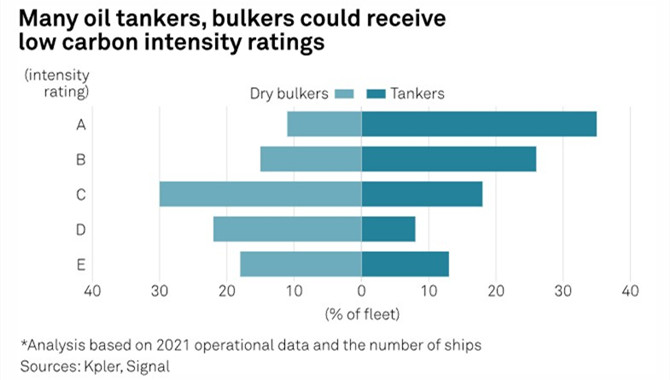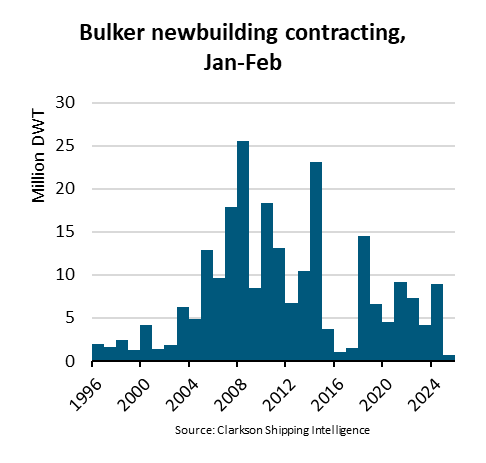The International Maritime Organization, UN’s global regulatory body for shipping, will soon introduce its first set of emission regulations despite controversies surrounding its Carbon Intensity Indicator which comes into force in 2023.
From January 2023, companies operating ships of 5,000 gross tons or more will need to collect voyage and fuel consumption data to calculate the carbon intensity of their vessel operations.
“This is IMO’s first venture into regulating the commercial operation of ships,” consultancy MarEcon’s director Martin Stopford told S&P Global Commodity Insights, describing the indicator as “an experiment.”
While recognizing the IMO’s willingness to tackle emissions should be appreciated, several major flag states and trade bodies have slammed what they perceive as flaws in its calculation methodology for CII, while environmentalists criticized its lack of punitive measures.
In October, Bahamas and Liberia teamed up with the International Chamber of Shipping, BIMCO, INTERTANKO, World Shipping Council and Interferry to call on the IMO to revise the indicator’s formula in a filing.
For each ship, CII is calculated as its annual CO2 emissions per sailing distance multiplied by vessel capacity in deadweight or gross tons, and the organizations argued that “correction factors” should be applied to ships with short voyages and long port stay.
In some scenarios, those vessels will achieve worse ratings than their counterparts with the same technical design even when their absolute emissions are lower, according to the organizations’ analysis.
Sharing a similar view, INTERCARGO, another industry group, said in a separate filing that the IMO should amend the methodology to address such issues.
The lack of will by dry bulk shipowners to service ports with poor infrastructure and a long waiting time could “have potential damaging effects on regional development,” INTERCARGO said.
Some ship operators, including Oldendorff Carriers and Mediterranean Shipping Co., have also publicly called on the IMO to revise the CII formula due to similar concerns.

Trade implications
While submitting its annual data for 2023 to the IMO in the first quarter of 2024, each ship will be rated between A and E based on its individual CII score, and the same process will be repeated in the subsequent years.
Daejin Lee, lead shipping analyst at S&P Global Market Intelligence, expects the regulation to start reducing sailing speed from 2024 and potentially trigger the scrapping of ships unable to achieve acceptable ratings from 2025 onward.
Furthermore, the rating issue “would incentivize higher demurrage to reduce idling time and prevent further upside risk in congestion in coming years,” said Lee.
Some market players, like shipbroker Alibra Shipping, believe CII ratings will affect charter rates eventually, although there remains uncertainty as to when and how. Others are less convinced.
“I don’t think the CII rules will affect the freight markets in the next couple of years … after that, it’s hard to say,” said Peter Lindstrom, research head at Norwegian ship operator Torvald Klaveness.
In November, BIMCO, whose members control over 60% of the global fleet, proposed a new clause in its time charters that would put the onus on charterers to maintain CII ratings.
However, some major charterers like Cargill and Oldendorff have rejected such terms. “We don’t think the BIMCO clause as it is reflects the true nature of how the market functions,” Cargill told S&P Global in an email, adding that some factors like port congestion can be out of a charterer’s control.
Ineffective rules
Currently, the IMO requires a ship rated D for three consecutive years or E for one year to propose measures to improve its rating to at least C in the Ship Energy Efficiency Management Plan submitted to its flag state.
This could affect many ships on paper. Based on Kpler’s analysis of 2021 operational data, 8% of the global tanker fleet would be rated D and 13% as E.
In the dry bulk sector, Greek shipping group Signal estimates that 22% of the global fleet would be rated D and 18% as E.
However, the IMO has not explicitly stated any punitive action for ships that fail to improve their ratings.
“Incentives for compliance and penalties for non-compliance could be improved,” said Antonio Santos, federal climate policy director at the non-governmental organization Pacific Environment. “CII is likely … not cutting emissions in the first half of the 2020s.”
To achieve a continuous reduction in carbon intensity, the IMO plans to lower the CII scores needed to achieve each rating progressively. The 2023 thresholds are set to achieve a 5% cut from the 2019 levels of carbon intensity, followed by a 7% cut in 2024, 9% in 2025, and 11% in 2026.
Prior to 2026, IMO member states have promised to review the CII regulation and confirm the reduction trajectory from 2027 onward.
Tristan Smith, director of consultancy UMAS, said more aggressive cuts are required for the industry to contribute to the Paris Agreement’s goal of capping global warming at 1.5 degrees Celsius above pre-industrial levels.
“It’s a very weak policy,” Smith said. “It’s all pointing to the need for much more effective regulation and improvements in CII.”
Source: Platts
The opinions expressed herein are the author's and not necessarily those of The Xinde Marine News.
Please Contact Us at:
media@xindemarine.com


 Ningbo Containerized Freight Index Weekly Commentar
Ningbo Containerized Freight Index Weekly Commentar  Ningbo Containerized Freight Index Weekly Commentar
Ningbo Containerized Freight Index Weekly Commentar  Ningbo Containerized Freight Index Weekly Commentar
Ningbo Containerized Freight Index Weekly Commentar  BIMCO Shipping Number of the Week: Bulker newbuildi
BIMCO Shipping Number of the Week: Bulker newbuildi  Ningbo Containerized Freight Index Weekly Commentar
Ningbo Containerized Freight Index Weekly Commentar  Ningbo Containerized Freight Index Weekly Commentar
Ningbo Containerized Freight Index Weekly Commentar